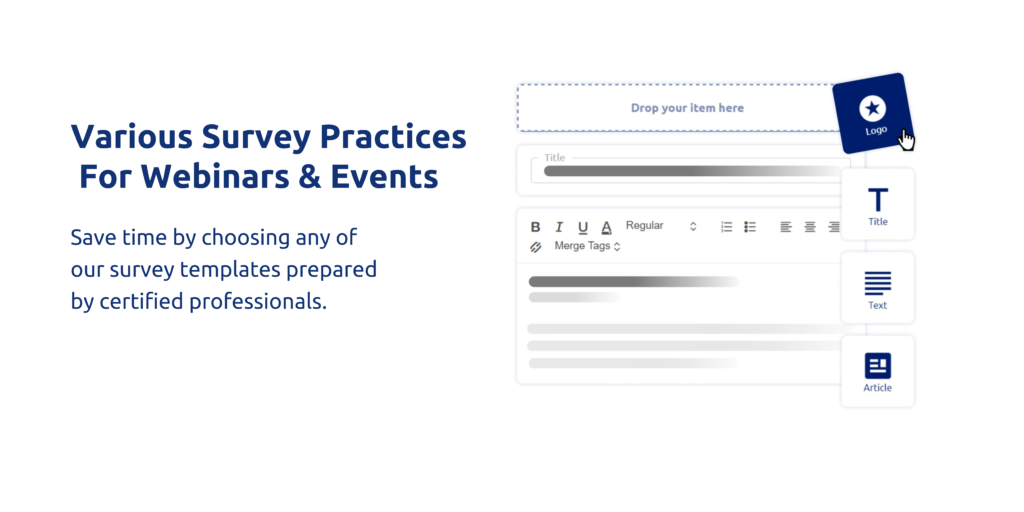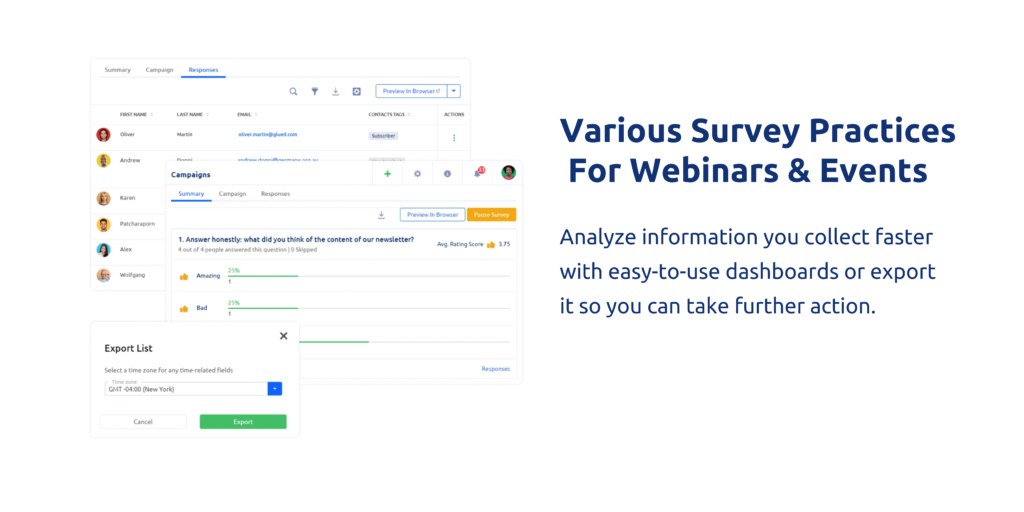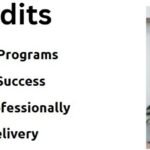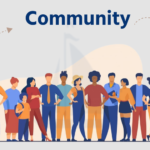Surveying individuals after webinars and events is an effective manner to gather comments, examine attendee satisfaction, and discover regions for improvement. Right here are numerous survey practices for webinars and activities.
Also mentioned here: Various Survey Practices for Webinars & Events
Post-Event Feedback Survey
Additionally, a post-event remarks survey is a critical tool for gathering insights from attendees after a webinar or event has concluded. Consequently, here is how to create an effective post-event remarks survey.
Introduction
To start, begin the survey with a brief introduction thanking contributors for attending the webinar or occasion. Express appreciation for their time and comments, and then explain the reason for the survey.
Overall Delight
Embody a query asking attendees to feel their fashionable delight with the webinar or event on a scale (e.g., from 1 to 5 or from terrible to top-notch). This gives a well-known indication of ways well the occasion met attendees’ expectations.
Content Relevance
Assess the relevance and value of the content material presented throughout the event. Ask attendees to feel the relevance of the topics protected and whether or not the content material addressed their desires or hobbies.
Presentation Quality
Firstly, examine the first class of the displays, which includes the clarity of facts, effectiveness of visuals, and engagement of speakers. Secondly, use rating scales or open-ended questions to gather feedback on the presentation fashion and delivery.
Speaker Effectiveness
When assessing the effectiveness of male or female speakers or presenters, ask attendees to rate an audio system based on factors such as expertise, communication skills, and ability to engage the audience.
Event Logistics
Acquire feedback on the logistics of the occasion, which includes registration procedure, timing, duration, and technical elements (e.g., audio/video fine, platform usability). Emerge as privy to any regions in which enhancements are had to beautify the attendees.
Tips for Improvement
Additionally, provides a possibility for attendees to offer pointers or suggestions for enhancing future occasions. Furthermore, encourage participants to share their thoughts on topics, formats, or speakers they would like to see in future sessions.
Chance to Propose
Moreover, utilize the net Promoter rating (NPS) approach to evaluate attendees’ likelihood of recommending the event to others. Ask individuals to price, on a scale from zero to ten, how probably they may be to advise the event to buddies or coworkers.
Open-Ended Feedback
Moreover, encompasses open-ended questions to capture qualitative comments and precise feedback from attendees. Additionally, inspire contributors to share their thoughts, insights, and any additional comments they may have.
Contact Information (Optional)
Include an optional section for attendees to provide their contact records if they would love to be contacted to comply with or to get hold of updates on Destiny activities.
Closing Remarks
Thank contributors once again for his or her comments and participation. Explicit appreciation for their input and assure them that their remarks can be used to enhance destiny occasions.
Survey Length and Format
Hold the survey concise and smooth to finish, with a combination of score scales, more than one-choice questions, and open-ended responses. Restrict the wide variety of questions to keep away from survey fatigue and ensure a higher reaction price.
Additionally, by designing a properly crafted post-event feedback survey, organizers can acquire valuable insights. Consequently, they can understand areas for improvement and make information-driven options to decorate the general attendee’s amusement for future sports activities.
Internet Promoter Rating (NPS) Survey
Begin the survey with a quick advent explaining the purpose of the survey and thanking members for attending the webinar or occasion.
NPs Question
The center query of the NPS survey is: “On a scale of 0 to 10, how probable are you to recommend this webinar/occasion to a friend or colleague?” participants rate their chance to suggest on a scale from 0 (by no means likely) to 10 (extraordinarily possibly).
Follow-up Question (Optional)
Include an open-ended comply-with-up question to gather qualitative remarks from individuals who furnished low scores (zero) or high ratings (9-10) on the probability of endorsing a question.
Explanation of NPS
Offer a brief clarification of the NPS score manner and the way its miles are interpreted. For instance, ratings above 50 are considered high-quality, rankings between 0 and 50 are considered accurate, and rankings beneath zero can also indicate areas for development.
Closing Remarks
Thank individuals for his or her remarks and guarantee them that their responses might be used to enhance future webinars or occasions. Encourage them to provide additional feedback or tips if they have any.
Optional Demographic Questions
Keep in mind consisting of non-obligatory demographic inquiries to accumulate additional insights, consisting of the player’s task role, industry, or level of revel in.
Survey Length and Format
Preserve the survey concise and easy to complete to maximize response fees. Restrict the number of questions and use clear, honest language.
Analysis and Action
Distribution
Send the NPS survey to individuals rapidly after the webinar or occasion concludes using email or a survey platform. Additionally, recall sending reminders to inspire participation and increase response rates.
Examine the survey responses and calculate the NPS rating. Use the comments accrued to become aware of areas for development and make facts-driven selections to enhance future webinars or occasions.
By implementing an NPS survey for your webinar or occasion, you may successfully measure attendee pleasure and loyalty. Additionally, you can discover promoters and detractors, and take actionable steps to enhance the general attendee’s enjoyment.
You may also like to read: CPE/CPD Credits

Content Relevance Survey
First, a Content Relevance Survey is designed to assess the relevance and usability of the content supplied for the duration of a webinar or occasion. Additionally, here’s how you may create a Content Relevance Survey.
Introduction
Start the survey with a brief introduction thanking contributors for attending the webinar or event. Explain the motive of the survey, that is to acquire feedback on the relevance of the content material offered.
Rating Scale
Use a score scale (e.g., from 1 to 5 or bad to first) to evaluate the relevance of the subjects blanketed for the duration of the webinar or occasion. Members will rate the relevance of each topic based on their beliefs.
Content Evaluation
Offer a list of topics or sessions covered all through the webinar or event. Ask participants to feel the relevance of every subject matter personally.
For example
How relevant became the keynote presentation for your expert pursuits or desires? (score Scale)
How beneficial was the panel discussion on [specific topic] in imparting insights or sensible advice? (Rating Scale)
Did the breakout consultation on [specific topic] meet your expectations in terms of relevance and applicability? (Rating Scale)
Open-Ended Feedback
Additionally, include open-ended inquiries to permit participants to offer qualitative remarks on the content material covered at some point in the webinar or event. Moreover, encourage them to share their mind, pointers, or extra topics they would like to peer cover in future sessions.
Speaker Evaluation (Optional)
Additionally, it may be helpful to include questions that evaluate the effectiveness of each speaker or presenter. For example, participants could rate the speakers based on their knowledge, communication skills, and ability to engage the audience.
likelihood to Endorse
Additionally, it consists of a query to determine members’ chance to advocate the webinar or occasion to others based on the relevance of the content. This can be beneficial in assessing normal delight and target audience engagement.
Demographic Questions (Optional)
Furthermore, remember to include optionally available demographic questions to acquire additional insights into contributors’ backgrounds, interests, and needs. Additionally, these records can help tailor content material to meet the options of the target market.
Survey Length and Format
Preserve the survey concise and easy to finish to maximize response rates. Restrict the number of questions and use clear, truthful language.
Distribution
Ship the content material Relevance Survey to participants quickly after the webinar or occasion concludes. Additionally, consider using electronic mail or a survey platform. Moreover, bear in mind sending reminders to encourage participation and increase response fees.
Analysis and Action
Furthermore, examine the survey responses to identify regions of strength and opportunities for improvement in phrases of content relevance. In addition, use the comments amassed to inform future webinars or event-making plans and ensure that content aligns with participants’ hobbies and desires.
Additionally, by implementing a content Relevance Survey, you could gather treasured comments from participants on the effectiveness of the content material supplied throughout your webinar or occasion. Consequently, you can make informed decisions to enhance future sessions.
Speaker Evaluation Survey
A Speaker Assessment Survey is a precious device for accumulating comments on personal speakers or presenters at a webinar or event. Here’s how to create a Speaker Evaluation Survey.
Introduction
To begin with, start the survey with a short introduction thanking individuals for attending the webinar or event. Moreover, explain the motive of the survey, which is to collect feedback on the effectiveness of the audio system or presenters.
Speaker Identification
Truly become aware of every speaker or presenter being evaluated inside the survey. Include their call, name, and a quick description of their session or presentation.
Rating Scale
Use a rating scale (e.g., from 1 to five or bad to high quality) to assess diverse components of the speaker’s performance. Members will feed every speaker based on their understanding, communication abilities, engagement, and basic effectiveness.
Evaluation Criteria
Consists of questions that deal with precise components of the speaker’s overall performance. Examples of evaluation criteria include:
Understanding: Charge the speaker’s understanding and depth of expertise on the subject.
Readability: feel the speaker’s potential to speak thoughts surely and efficiently.
Engagement: Rate the speaker’s potential to seize and hold the target market’s interest.
Interaction: Charge the speaker’s responsiveness to target market questions and engagement with the target audience.
Standard Effectiveness: Price the general effectiveness of the speaker’s presentation.
Open-Ended Feedback
Encompass open-ended inquiries to allow participants to offer qualitative comments on each speaker’s strengths, areas for development, and any additional comments or suggestions they’ll have.
Probability to Suggest
Optionally, include a query to the degree of individuals’ likelihood to endorse the speaker to others primarily based on their overall performance. This will provide extra insight into the speaker’s impact and effectiveness.
Demographic Questions (Optional)
Moreover, don’t forget to include inclusive non-compulsory demographic questions to acquire extra insights into contributors’ backgrounds, hobbies, and needs. Consequently, these records can help tailor future presentations to better meet the preferences of the target market.
Survey Length and Format
Preserve the survey concise and easy to complete to maximize response prices. Restrict the number of questions and use clean, straightforward language.
Distribution
Send the Speaker Assessment Survey to contributors quickly after the webinar or occasion concludes. Subsequently, utilize email or a survey platform for distribution. Additionally, remember to send reminders to encourage participation and increase response rates.
Analysis and Action
First of all, examine the survey responses to pick out areas of electricity and opportunities for development for every speaker. Subsequently, use the comments accumulated to offer positive remarks to speakers and inform future speaker selection and presentation planning.
With the aid of implementing a Speaker Evaluation Survey, you can acquire treasured feedback from individuals on the effectiveness of individual speakers or presenters at your webinar or occasion. Consequently, you can make informed choices to enhance future displays.
Technical Experience Survey
Compare the technical elements of the webinar platform or event logistics by way of soliciting comments on audio/video, platform usability, registration procedure, and any technical troubles encountered during the event. Pick out areas wherein enhancements are needed to enhance the attendee’s enjoyment.
Demographic and Preferences Survey
Gather demographic facts and options from attendees to apprehend their backgrounds, hobbies, and needs. Ask questions about the industry, task role, business enterprise size, and desired subjects for destiny activities to tailor content material and advertising and marketing efforts as a consequence.
Future Content and Topic Survey
Additionally, solicit input from attendees on future content thoughts and subject matter preferences to tailor planning for upcoming webinars and activities. Furthermore, ask participants to signify subjects, audio systems, or formats they would love to peer in destiny classes to ensure continued engagement and relevance.
Follow-Up Surveys
Additionally, send observe-up surveys to individuals after the event to acquire additional comments on particular subjects, movements, or projects mentioned throughout the webinar. Use this opportunity to reinforce key takeaways, gather insights on implementation challenges, and provide additional resources or assistance.
Long-Term Impact Survey
Additionally, examine the lengthy-term impact of the webinar or event by way of sending an observe-up survey to contributors numerous weeks or months after the occasion. Moreover, measure adjustments in knowledge, behavior, or attitudes resulting from attending the event and collect testimonials or success stories for future marketing purposes.

Continuous Improvement Feedback Loop
Establish a comments loop to gather ongoing remarks from attendees and stakeholders and include insights into the destiny webinar and occasion planning methods. Frequently overview survey results, become aware of trends, and implement changes to enhance overall attendance.
By imposing these survey practices, organizers can collect treasured insights. Additionally, they can measure the effectiveness of their webinars and events, and constantly enhance future offerings to better meet the needs and expectancies of attendees.









2 responses to “Various Survey Practices for Webinars & Events”
Thank you for your sharing. I am worried that I lack creative ideas. It is your article that makes me full of hope. Thank you. But, I have a question, can you help me?
Its our pleasure to help you. What questions do you have?